The King of Layer2 Revenue: Analyzing the Combination of Base Priority Fees and DEX’s “Money Printing”
Original article by: Zack Pokorny
Original translation: Luffy, Foresight News
Base, created by cryptocurrency exchange Coinbase, is the most profitable platform in the Ethereum Layer2 (L2) network, and its daily revenue often exceeds the sum of all other top Rollup projects. In the past 180 days, Base's average daily revenue reached $185,291, far exceeding the second-ranked Arbitrum's $55,025.
Clearly, Base has become a consistently high-revenue platform, but what is driving its economic activity? What advantages does Base have that other leading L2s don’t have that allow it to create such high value?
This report will explore Base’s fee structure and highlight the activities that drive its revenue growth. We find that Base’s sorting mechanism and decentralized exchange (DEX) activity are key drivers.
Base's transaction sorting mechanism
The ordering of transactions on Base is determined by two variables:
- Transaction submission time (latency);
- The fee (economic incentive) paid by the sender relative to the complexity of the transaction.
This mechanism is similar to the operating model of logistics companies such as UPS: packages are sent in the order in which users deliver them, while allowing senders to pay an additional fee to choose "expedited" delivery for faster delivery services. The priority fee mechanism forms a dynamic auction market, which is consistent with the Ethereum EIP-1559 fee model and achieves a balance between delivery time and economic incentives.
Specifically, transactions on Base include a "base fee" (lowercase "b", not to be confused with the name of the chain) and a priority fee: all users must pay the base fee when sending transactions, while the priority fee is optional and is only used to speed up transaction execution.
But how does the sorter decide which "expedited" transaction to prioritize? It does not directly consider the total fee, but focuses on the price per unit of Gas (required computing resources), that is, the cost-effectiveness of the resources required for the transaction and the benefits it brings.
Let’s use the logistics company example again: Assume that the delivery truck has limited space (similar to the gas limit of the block), and the driver (sequencer) wants to maximize the tip income within the limited space. At this time, there are two packages:
- A large package has a basic shipping fee of $50, but a priority fee of only $10 and takes up half the space of a truck;
- For a small package, the basic shipping fee is only $20, and the priority fee is also $10, which takes up very little space.
Even though the total cost of a large package is $30 higher than that of a small package, drivers will still prioritize loading small packages because they are more cost-effective in terms of space occupied.
Base's sorter follows the same logic, prioritizing transactions with the highest priority fees per unit of Gas, thereby ensuring that the blocks with the "highest cost" of computing resources are also the blocks with the highest returns. Therefore, when two users submit transactions at the same time, regardless of transaction complexity or total fees, the user who pays a higher priority fee per unit of Gas is more likely to have his or her transaction included in the block first.
The following diagram shows this process:
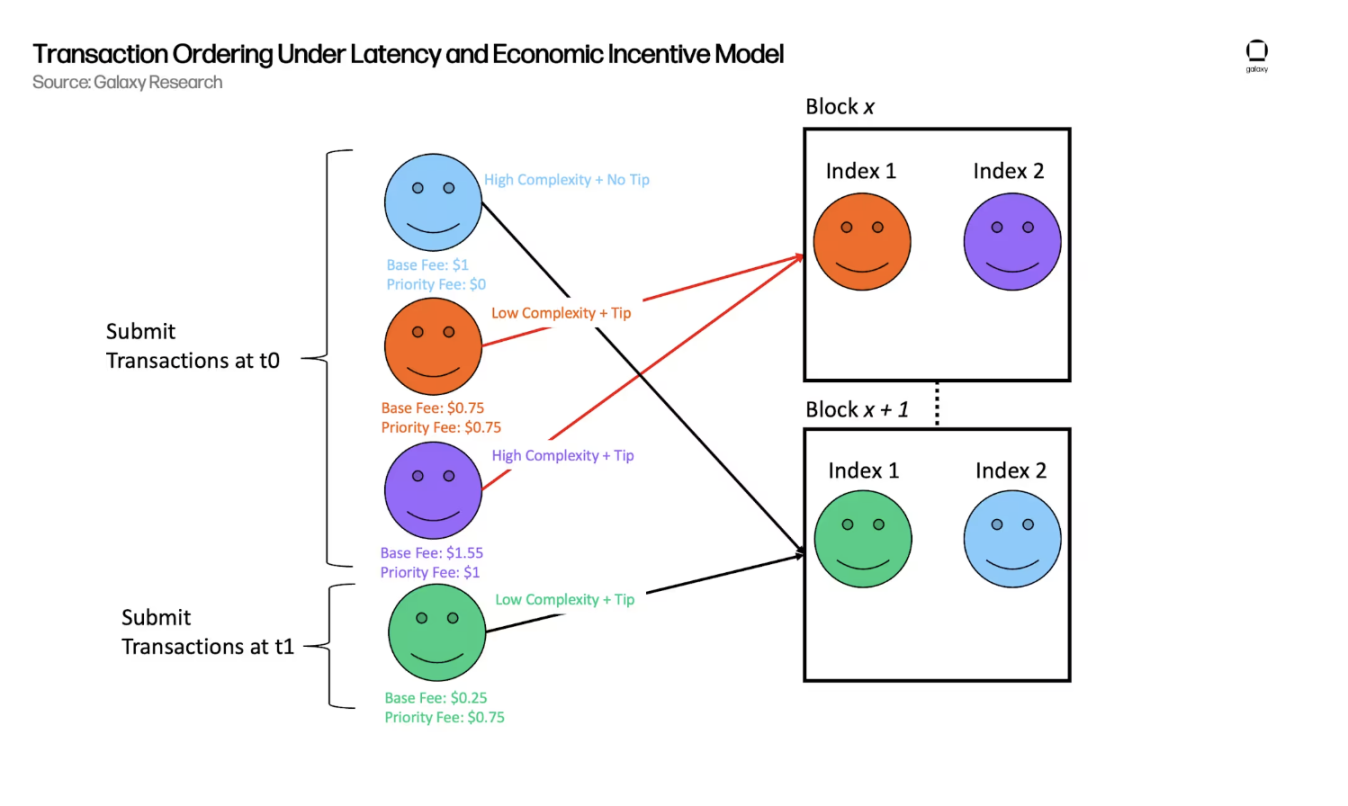
Why is this important? How does Base differ from competing chains?
Base's EIP-1559 style fee model creates a continuous open market auction environment for block space, where users bid directly for block space based on the urgency and profitability of their transactions. Therefore, while there is still an element of latency competition, the economics allow sorter revenue to grow directly with block space demand and the profitability of on-chain transactions.
This is in stark contrast to Arbitrum’s primary sorting mechanism. Arbitrum uses a strict “first come, first served” (FCFS) model, where users compete primarily on latency rather than economic cost. In this model, the main competition is not who can pay more fees, because all users have the same per-gas fee and no priority fees are used, but who can get transactions to the sorter the fastest. This leads to a “latency race”, where professional players ensure that their transactions are processed first by investing in low-latency infrastructure. In this environment, Arbitrum’s fees only grow with the scale of demand, and cannot effectively reflect the profitability or urgency of individual transactions.
In April 2025, Arbitrum launched the Timeboost feature, which aims to create a more flexible FCFS system that enables sequencers to obtain benefits similar to priority fees. In fact, Timeboost adds a "fast lane" for transaction execution to Arbitrum, which users can use for a limited time through bidding. Users who enter the fast lane can get near-instant execution, while other users are still processed in FCFS order, with only a 200-millisecond delay added to compensate for the priority of the fast lane. Although Timeboost introduces a form of priority bidding, its mechanism is more predictive than reactive compared to Base's priority fee model. Bidders must predict the potential total revenue for a certain period of time in the future and bid based on estimates. This means that Arbitrum receives a fixed fee from the winning bidder, regardless of the actual revenue during that period. This proactive fixed-rate model is not as effective as a reactive system in which users bid individually for each transaction in capturing the value of sudden high-yield transactions.
How much revenue does Base generate?
Over the past 180 days, Base’s average daily revenue was $185,291. In comparison, Arbitrum’s average daily revenue was $55,025, and the other 14 Ethereum L2 networks’ average daily revenue combined was $46,742.
So far this year, Base’s total revenue has reached $33.4 million, Arbitrum’s $9.9 million, and the other 14 L2 networks’ $8.4 million.
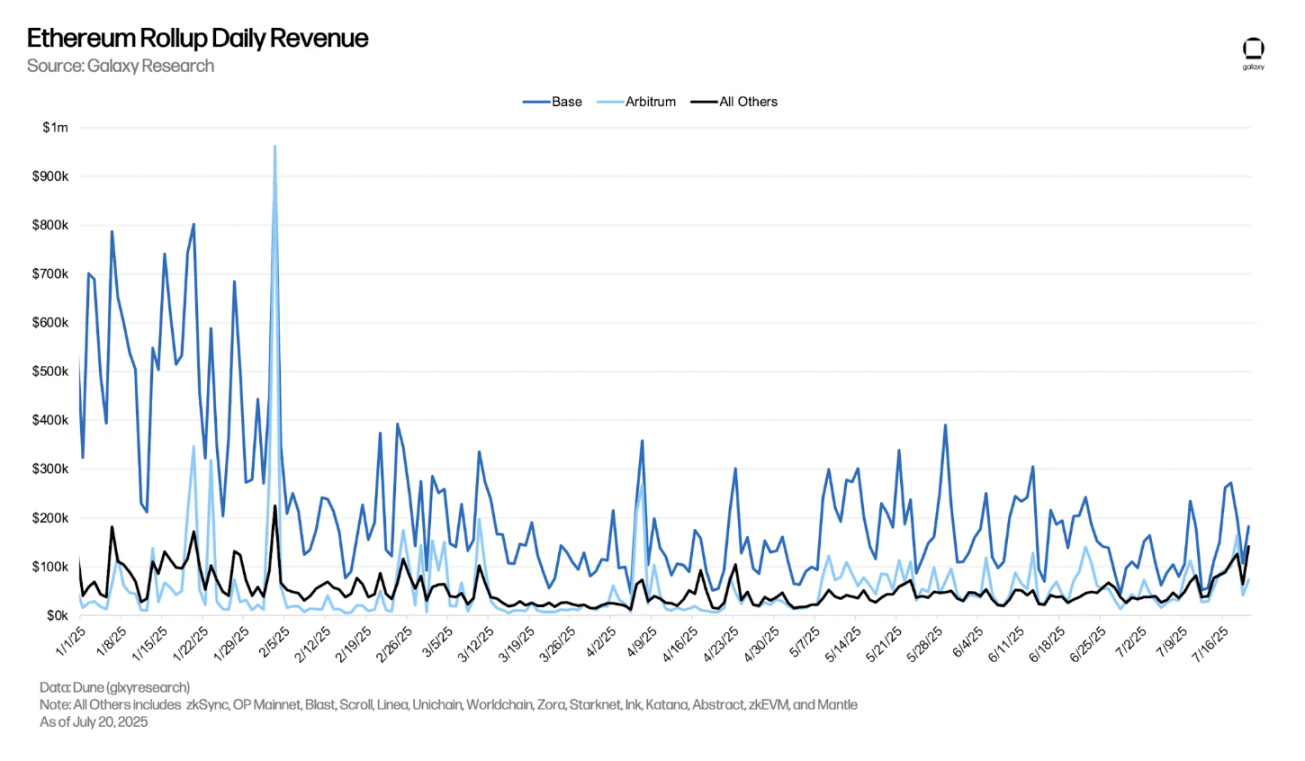
In relative terms, Base has captured 64% of the total revenue of the top 15 Ethereum L2 networks ranked by total bond value over the past 180 days. Its share has grown significantly over the past year, up 48 percentage points from a daily average of 37% in July 2024, based on the 7-day moving average of daily revenue share. As of July 20, Base's share of Ethereum Rollup revenue has fallen to 49.7% due to increased activity on other chains.
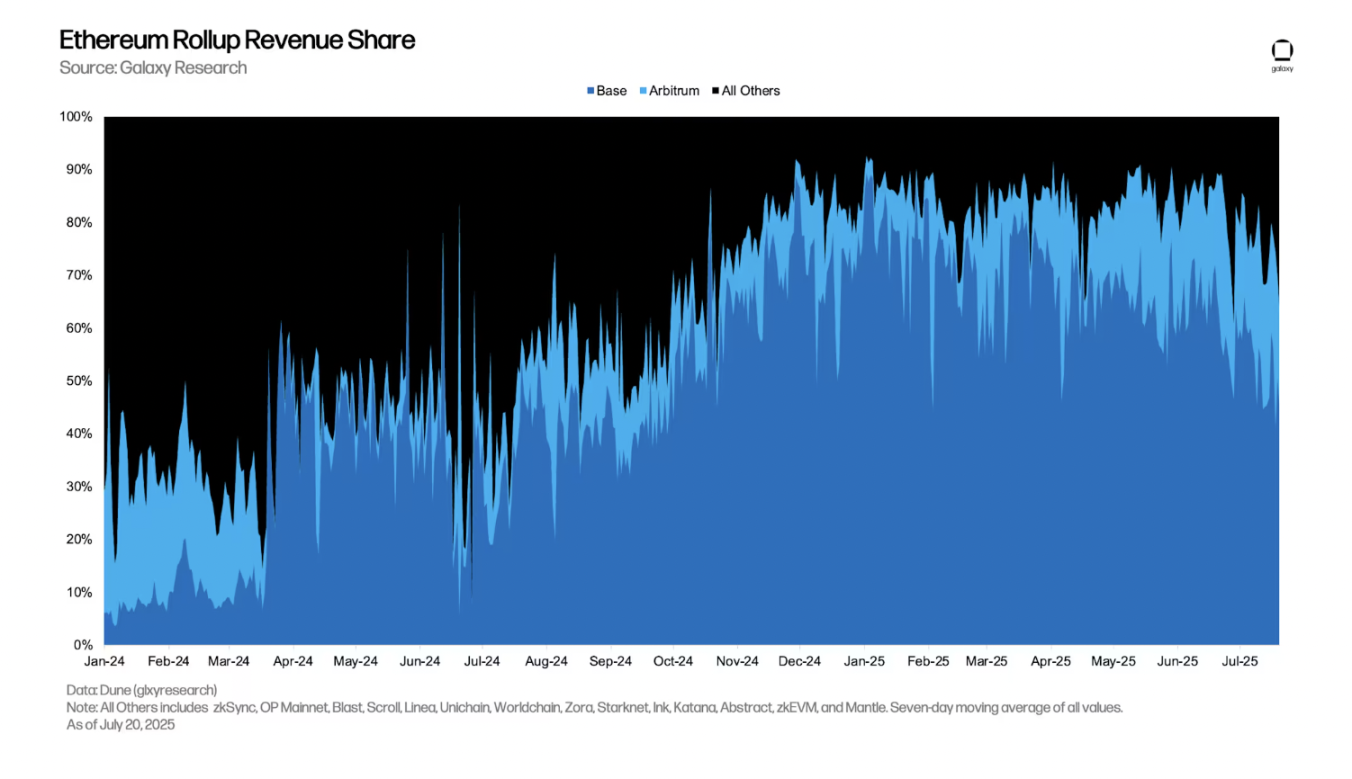
The important role of priority fees
Transaction fees on Base consist of two main components and an optional priority fee :
- Layer1 (L1) fees: used to pay for submitting a batch of L2 transactions to the Ethereum mainnet. After the Ethereum Pectra upgrade introduced "blobs" through EIP-4844 in March 2024, the L1 fee portion of Base (and general L2 transactions) dropped significantly. This is because submitting batches of data through blobs is more economically efficient than submitting them as call data in L1 transactions.
- Base Fee: A mandatory fee for executing transactions on Base. Set by the protocol, it fluctuates based on how much space has been used in the previous block - the busier the network, the higher the base fee; the busier the network, the lower the base fee.
- Priority Fee: An optional fee, also called a "tip," used to prioritize the execution of a transaction. Priority fees help a transaction get a higher position in a block, or ensure that the transaction is included in the current block instead of being delayed to the next block. A block can contain thousands of transactions, which are executed in order according to their slots. Typically, the first slot in a block has the highest value because transactions in that slot are executed first and are not interfered with by subsequent transactions.
Priority fees are the main source of Base's revenue, and users get accelerated execution through bidding. In the past 180 days, Base's average daily priority fee revenue reached $156,138, accounting for 86.1% of its average daily revenue.
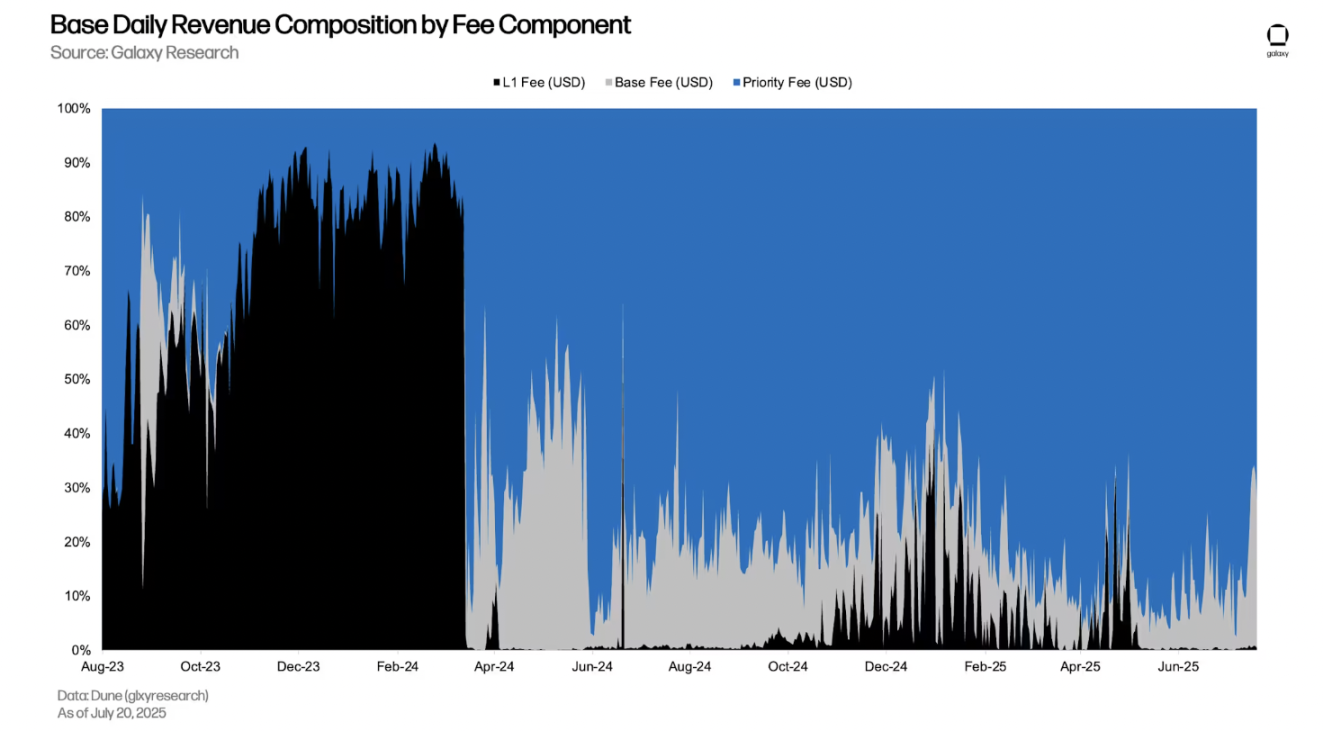
Specifically, priority fees for the top slots of the Base block are a significant contributor to sorter revenue, as users compete for a spot near the top of the block. Priority fees paid by transactions in the first slot of a block alone have contributed 30% to 45% of daily revenue since 2025. In addition, priority fees paid by transactions in the top 10 slots of each block have contributed 50% to 80% of daily revenue over the same period. However, in the weeks after July 5, the share of top slot priority fees in total daily revenue dropped significantly. This is attributed to two factors: 1) increased traffic pushed up base fees, which in turn diluted the share of revenue from priority fees; and 2) the implementation of “Flashblocks” on July 16 (more on this below) caused high-priority transactions to fall into lower slots in the block (but as we will see, this is not a bad thing).
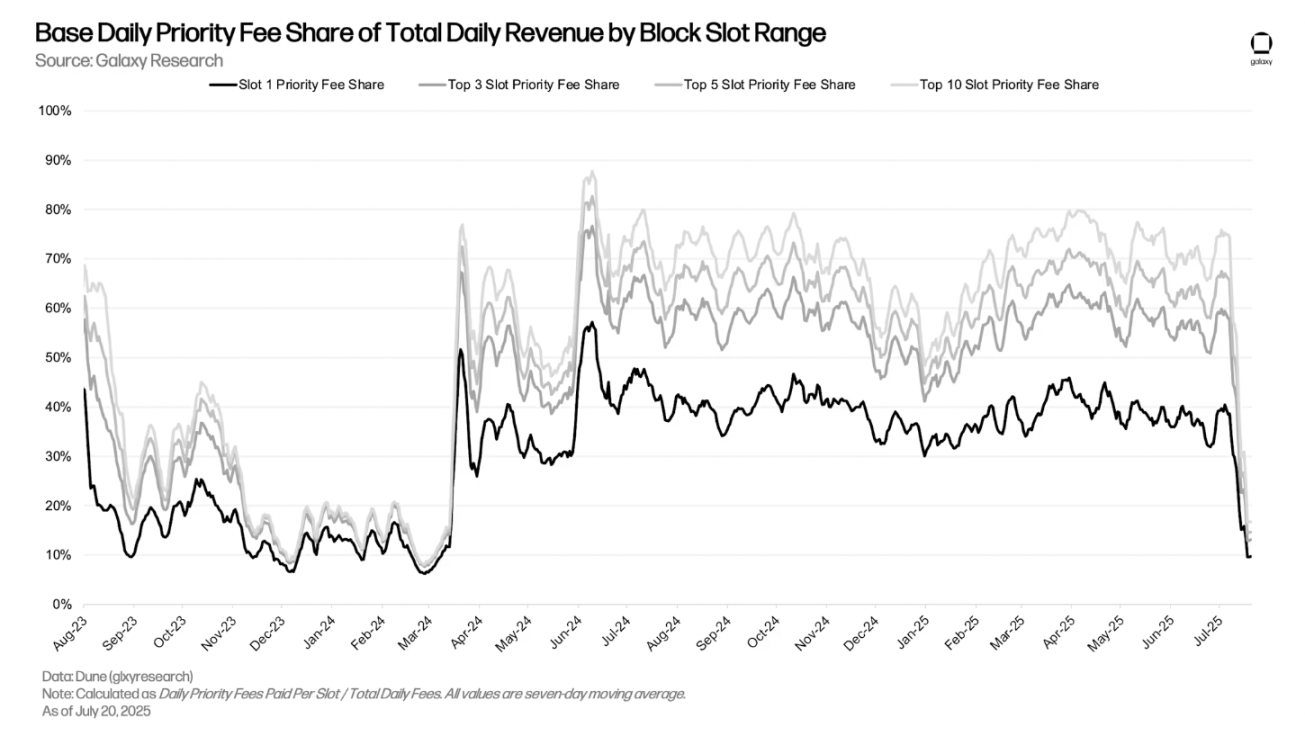
Priority fees come mainly from a small number of addresses, with 64.9% of priority fees coming from just 250 addresses over the past year. The top address paid 3.6% of all priority fees during the same period, which is equivalent to $1.99 million based on the ETH price at the time the fees were paid.
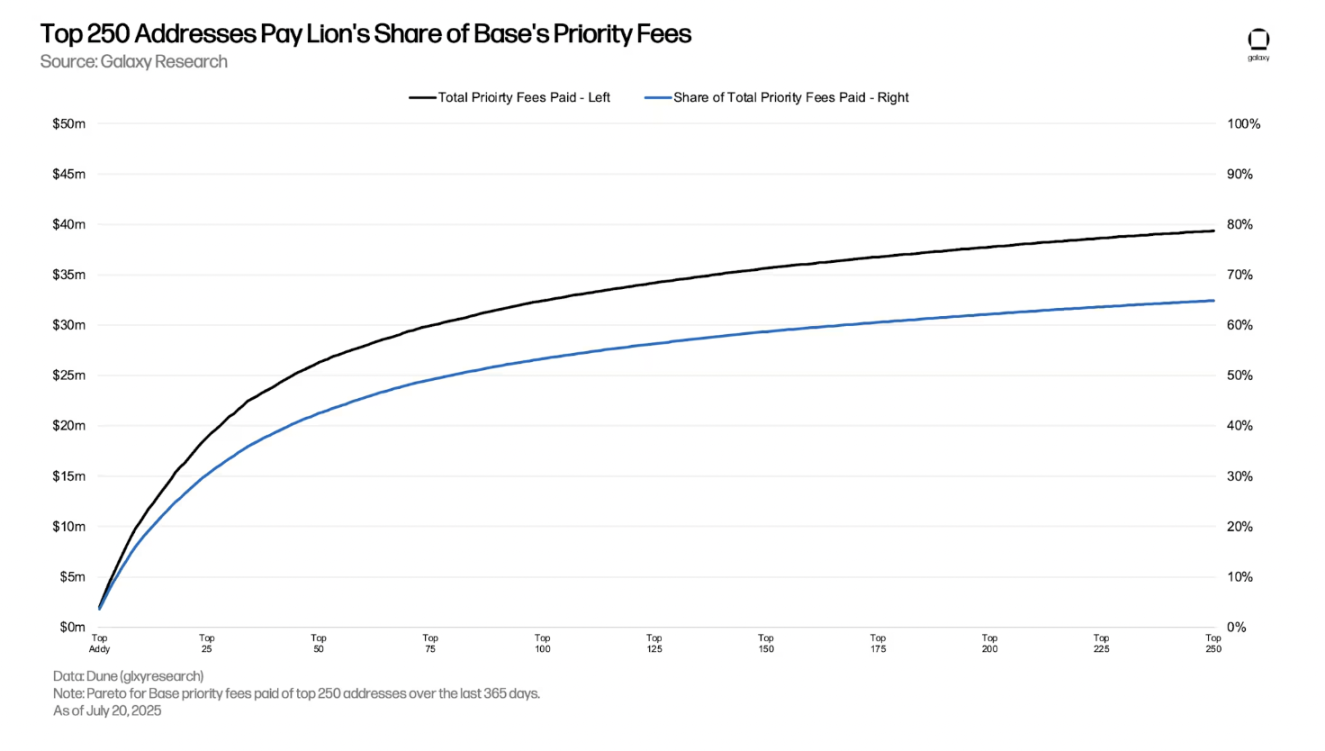
What is Flashblocks?
Developed by Flashbots, Flashblocks aims to increase the speed of transaction processing on Base. To achieve this goal, it introduces "subblocks", which are high-confidence pre-confirmations of sub-parts of a block created approximately every 200 milliseconds. For example, a block can contain three different sub-parts, and users can get pre-confirmations of transactions for these sub-parts before the block is confirmed on the chain at a set 2-second interval. This allows end users to experience transactions as almost instantaneous even if Base's block interval remains unchanged, resulting in a smoother and more responsive experience.
Why is this critical for Base network fee analysis by slot? Because from a transaction ordering perspective, each "subblock" is actually considered a new block. Therefore, a high priority fee transaction may fall into a lower slot of the overall "confirmed block" but be at the top of a "pre-confirmed subblock".
The following figure shows the difference in the priority fee distribution of the first 200 block slots before and after the implementation of Flashblocks. The black bar graph represents the priority fee share of each slot; the blue line represents the cumulative share of all slots up to that slot (Pareto distribution).
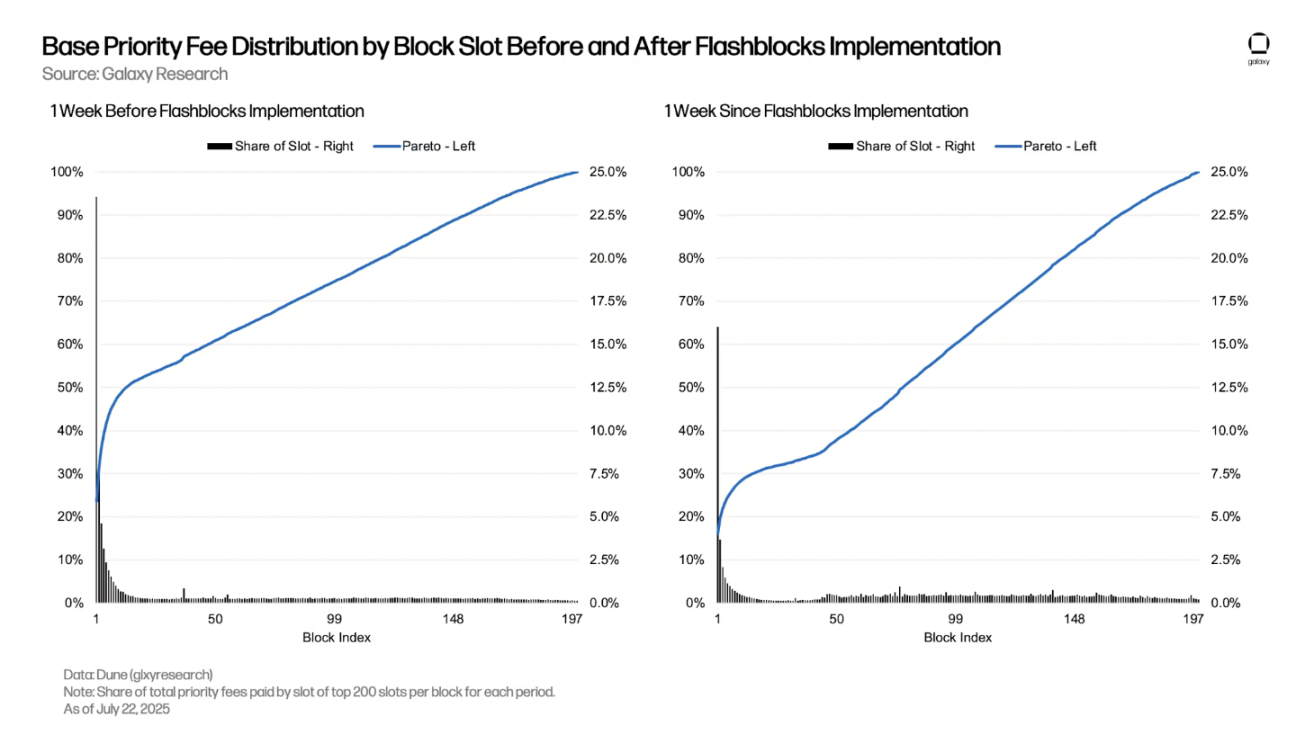
In the week before Flashblocks, the Pareto curve rose sharply in the first 10 slots, then increased linearly toward slot 200. In contrast, in the week after Flashblocks, the Pareto curve was flat at the lowest slots, then began to rise steeply around slot 50 of each block — indicating that high-priority fee transactions are falling into later slots in confirmed blocks.
The impact of DEX trading
DEX activity on Base is very active. Among all Ethereum L2 networks, Base has the largest daily DEX trading volume, accounting for 50% to 65% of L2 network DEX trading volume, and its DEX total value locked (TVL) is the highest among all L2 networks (excluding perpetual futures DEX).
The high level of DEX activity is a major reason why Base priority fees remain high. Of the total daily fees earned by the Base sorter, 50% to 70% comes from priority fees for DEX transactions. However, since July 7, the proportion of DEX transaction fees in total daily fees has dropped from 67% to only 34%. This is attributed to two aspects: 1) The increase in base fees dilutes the share of priority fees; 2) Intensified competition for on-chain block space forces users to pay priority fees for non-DEX transactions.

Since 2025, priority fees paid by DEX transactions in the first slot alone have contributed 30% to 35% of the total daily priority fees, while priority fees paid by DEX transactions in the top three slots have contributed 50% to 62% of the total daily priority fees. The recent decline in the share of DEX priority fees in the top slots is due to the increase in overall competition on the chain, which has led to an increase in priority fees for non-DEX transactions, and the implementation of Flashblocks, which has caused high-priority DEX transactions to fall into lower slots in the block.
in conclusion
Through the analysis of Base's DeFi and revenue structure, we found that:
- Preferred fees make up the vast majority of revenue;
- Over 60% of priority fees in the past year came from just 250 addresses;
- High DEX trading volume and TVL;
- Priority fees from DEX trading contribute nearly three-quarters of the total priority fees.
These points suggest that Maximum Extractable Value (MEV) trading, especially competitive activities such as DEX arbitrage, is an important source of revenue for Base sorters. The EIP-1559 style fee model adopted by the sorter is a direct mechanism for achieving this: it transforms competition for block space from an inefficient latency-based race to an efficient economic auction.
By charging priority fees to users willing to pay for urgent inclusion, this model enables sequencers to capture and monetize the competitive value of block space more efficiently than traditional first-come, first-served or purely latency-driven systems.
- 核心观点:Base 是以太坊 L2 中创收最强的平台。
- 关键要素:
- 日均收益 18.5 万美元远超竞品。
- 优先费用机制贡献 86% 收入。
- DEX 交易驱动 50-70% 优先费用。
- 市场影响:推动 L2 经济模型创新。
- 时效性标注:中期影响。



